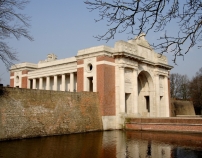| First Name: | William Dunston | Last Name: | GADSDEN | |
|---|---|---|---|---|
| Date of Death: | 08/05/1915 | Lived/Born In: | Muswell Hill | |
| Rank: | Rifleman | Unit: | London12 | |
| Memorial Site: | Menin Gate, Ypres | |||
Current Information:Age-19 24, Coldfall Avenuie, Muswell Hill
Battle of Frezenberg Ridge (8 May-13 May) In April 1915 the Germans, using gas for the first time, launched an all out attack on the salient around the Belgian town of Ypres. It became a gargantuan struggle that lasted well into the next month and at the end of it, the salient, though drastically reduced, still stood. The Battle of Frezenberg Ridge which began on 8th May, 1915 was a further attempt to destroy the Ypres salient. The name is deceptive because the Frezenberg ridge, which lay to the north-east of the town rose to only 50 metres above sea level and was one of a series of low ridges that ran in a generally westerly direction and branched off the main ridge that ran north-easterly from Kemmel to Passchendaele. Nevertheless, it gave a commanding view down on to the town of Ypres and for that reason it was strategically important. At dawn on 8th May, 1915 there was a violent bombardment on the front held by 28th Division on the Frezenberg Ridge the full fury of which lasted for four hours. Parapets were flattened and trenches destroyed. At 8.30am the German guns lifted onto the support trenches and approach roads and their infantry assaulted the front of the ridge with the brunt of the attack falling on 3rd Monmouth and 2nd Royal Lancaster of 83 Brigade and 1st Suffolk and 2nd Cheshire from 84 Brigade. This first attack was driven off as was the second, which came after another half hour bombardment, but it left nearly all the men in the front line either killed or wounded or buried. It was impossible to get reinforcements to them so when the third attack came at 10am, again either side of Frezenberg village, it succeeded, especially as it coincided with Brigade orders for the front line to be evacuated. The survivors of 3rd Monmouth and 2nd Royal Lancaster fell back to their support trench as did the extreme right of 1st Suffolk. At this stage the 12th London battalion of 84 Brigade were ordered forward to support 1st Monmouth. A, B and C companies led this advance but first they had to pass through gaps in the wire in front of the GHQ line. German machine guns were trained on these gaps and many of 12th London got no further than this point. Those who survived this first ordeal then had to advance 200-300 yards across ground which was being heavily shelled and which was alive with German rifle and machine gun bullets. Many fell but others reached the line. The Germans were so surprised by the audacity of this attack that they assumed that it had been made by fresh troops with strong support behind them. Consequently they themselves dug in and did not continue with their own attack that day. If they had known that 12th London were practically the last remaining troops between them and Ypres they would surely have pressed on. The exhausted remnants of 12th London spent two more days in these positions before being withdrawn. By the end of the Battle of Frezenberg Ridge, the British had been pushed back so that the GHQ line was now the front line, but Ypres was saved. The action fought by 12th London on 8th May 1915 at Frezenberg Ridge was described in the Official History of the war as one of the heroic episodes of the conflict. Heroic it may have been but it cost the Rangers dear and they came out of it with only 53 men left standing. One of their many casualties was William Gadsden who was killed on 8th May. |
||||
| « Back to Search Results | ||||
| If you think any of the information shown here is incorrect, Click Here to submit your amends and comments | ||||




